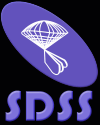 SDSS-II Supernova Survey Data Release
SDSS-II Supernova Survey Data Release
 SDSS-II Supernova Survey Data Release
SDSS-II Supernova Survey Data Release
As part of the SDSS-II supernova survey, a 2.5 degree wide region along the celestial equator, from roughly -50 < RA < 59, (SDSS Stripe 82) is imaged repeatedly for three months (September, October and November) in each of three years (2005-2007).
SN scans from 2005, 2006, and 2007 Fall observing are now online!
We emphasize here that this release includes data taken under conditions below the usual SDSS survey standards. Before proceeding, read this note about data quality below! Because of the variable data quality, we have chosen at this early stage to provide uncalibrated object catalogs (i.e. instrumental fluxes in raw data units). Once the end-user has determined that this photometry is reasonable for their needs, absolute photometric calibration can be attained by using photometry of stripe 82 from the most current standard SDSS data release (DR7).
For information about the individual imaging runs in this data release (date, RA range, data quality), please see the run list.
For access to these data, please use the Stripe 82 CAS and DAS database interfaces.
Obsolete: For access to these data, please use the DAS
Obsolete:To determine which imaging runs contain data at a particular set of coordinates, please use the DAS footprint server.
Please give appropriate credit to the SDSS-II collaboration if these data are used in a scientific publication. See the SDSS acknowledgements for non-commercial use.
In the interest of acquiring dense temporal coverage in this phase of the survey, imaging is done even when conditions are significantly poorer than the "survey standard". We provide here all such data which were able to be processed through the normal SDSS pipeline. This data set therefore includes imaging taken through clouds, in "grey" time (i.e. moony) and with seeing poorer than the SDSS standard of 1.7 arcseconds.
While the data taken under survey standard conditions should be of equal quality to that of regular SDSS data releases, we make no claims about the quality of this data set as a whole. In particular, the performance of the SDSS pipeline has not been fully characterized under poor conditions, and the potential for systematic error exists. It is left to the end-user to assess which of these data are appropriate for their science requirements. We provide a list of the runs included with links to the data on nightly transparency and seeing here.
Transparency: the linked plots show the standard deviation of the pixels in the infrared sky map as a function of UT, and also the sky brightness. Because of auto-scaling in the camera, the latter is generally not meaningful. Therefore, the top plot of the standard deviation should be used to assess photometricity. The line at std = 7 is a suggested threshold, but note that this is an all-sky value.
Seeing: the linked plots show the median FWHM as a function of imaging frame number. It is computed using all objects classified as stars in each r-band frame. The line at 1.7 arcsec is the nominal criterion for "survey quality" in the SDSS.
Feedback, questions and comments: Helpdesk form